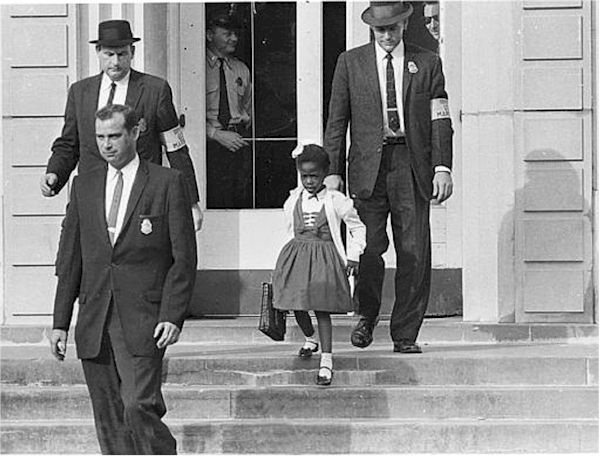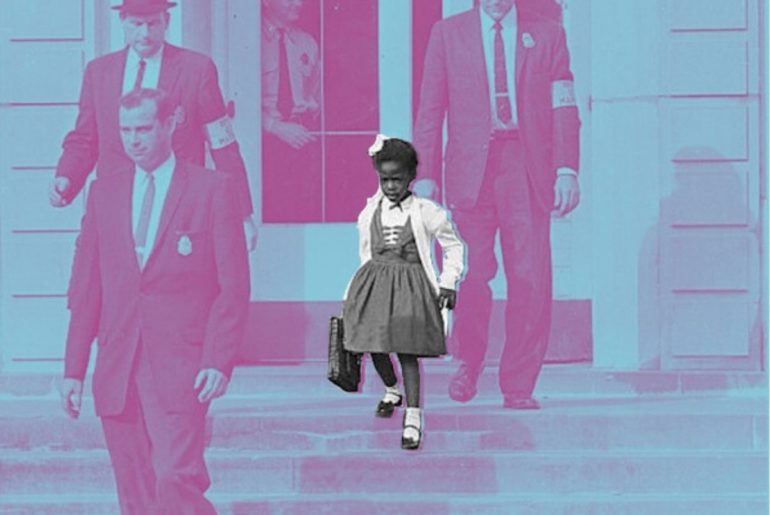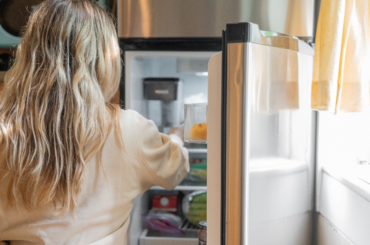Segregation, white supremacy and racism seem like really big topics to try to discuss with kids. That’s why specific stories and images are so important, so kids can find a way to relate the concepts to their own lives. One place in history to start? Segregation in schools.
Show your child a picture from history that’s focused on one little girl doing something completely relatable — walking out of school at the end of the day. Keep scrolling for the powerful photo of Ruby Bridges, and a script to help you discuss this piece of history with kids.
The photo:
This is a photo of 6-year-old Ruby Bridges being escorted out of William Frantz Elementary School by U.S. marshals, after schools in the South were ordered to desegregate.

Ask your child these questions to get them thinking:
- Is there anything surprising about the way this little girl is leaving school?
- Who do you think is walking next to the girl?
- Where are all of the other students at the school and why aren’t they near her?
Now, see how you can begin to explain to kids what’s happening in the picture and how it ties to white supremacy.
Here’s what you can say:
“The little girl in the picture is Ruby Bridges, who was 6 years old when she was the first Black student to attend an all-white school in New Orleans in 1960. She had to be escorted to and from school by U.S. marshals because a lot of people were angry about the school becoming integrated (racially mixed).”
“On her first day, and for months afterward, there was a crowd of white people outside the school chanting things like, ‘Two, four, six, eight, we don’t want to integrate,’ and holding signs saying they didn’t want Black students at their school.”
“Segregation didn’t just happen in schools, though. In our country, there used to be White-Only and Black-Only sections of places like parks, theaters, buses, waiting rooms, and even cemeteries. Black people couldn’t use the same public drinking fountains or phone booths as white people.”
“During Ruby’s first year at the school, she was the only kid in her classroom because none of the white families wanted their kids to be in her class. Most of the white parents pulled their kids out of the school completely.”
“The white segregationists (people who wanted to enforce the separation of different racial groups) were so afraid of change that they didn’t even see Ruby’s and other Black families as regular people who just wanted a good education.”
“Those segregationists seemed to believe that white people are better than people of other races and cultures, and that white people should have control over everyone else. The way that belief gets turned into widespread actions or policies — like segregating schools — is what we call white supremacy.”
Here’s an activity to get kids to dig deeper:
Read some of these signs that white segregationists (some of them children) were holding up outside of Ruby Bridges’ new school:
- “We want to keep our school white”
- “All I want for Christmas is a clean white school”
- “We want segregation”
- “Integration is a mortal sin”
If you lived near this school in 1960 and saw a neighbor hold up one of these signs, what would you say or do? Make a list of possible responses and actions.
Here’s how you can start to explain the role white supremacy still plays in our society:
“Unfortunately, even though things like segregation in schools aren’t allowed here anymore, historical and current white supremacy still exists and impacts Black lives.”
“For example, a bank process called redlining used to make it so Black people couldn’t get loans for homes in certain neighborhoods. Even though that’s illegal now, their financial growth and ability to move to higher-income areas was denied for so long that communities of color still feel the negative effects of that discrimination today.”
“But discrimination is still happening now, too. In fact, white nationalist and other racist groups are still active and constantly working to recruit new members and spread their worldview. But they’re just one of the more visible representations of white supremacy in our society today. Sometimes it’s more subtle.”
“Black people face issues like having less access to quality education, getting unfairly passed over for high-paying jobs, being more likely to get stopped and frisked by police, and not getting equal medical treatment — just because of the color of their skin. It also means that Black people are less likely to be represented in places like movies or textbooks.”
“The fact that this is still happening means we have to ALL learn more about it and work together to stand up against racism, discrimination, and white supremacy wherever we find it.”
Reflection questions to ask your child:
- How do you think you would feel if you had Ruby’s experience on your first day (or first few months) at a new school? Have you ever felt like that, or do you think anyone else in your school has?
- Why do you think so many white people were so angry about a 6-year-old Black girl attending that elementary school? Do you ever witness that same kind of anger today?
- Who were the other white people in this story besides the segregationists? (Hint: Ruby’s teacher, the U.S. marshals, etc.) What role did they play?
- Ruby Bridges is still alive today (she’s 69 years old), and so are many of the children and families who were protesting her arrival at the school. Is that surprising? Why or why not?
- If you see someone being bullied or harassed because of the color of their skin, what are some ways you could support that person?
- What do you think should have happened to the white people who were rioting and protesting against Ruby? What do you think they can do to make up for their mistake?







